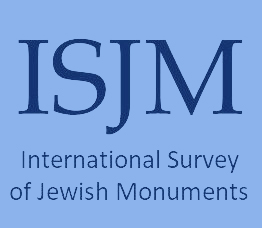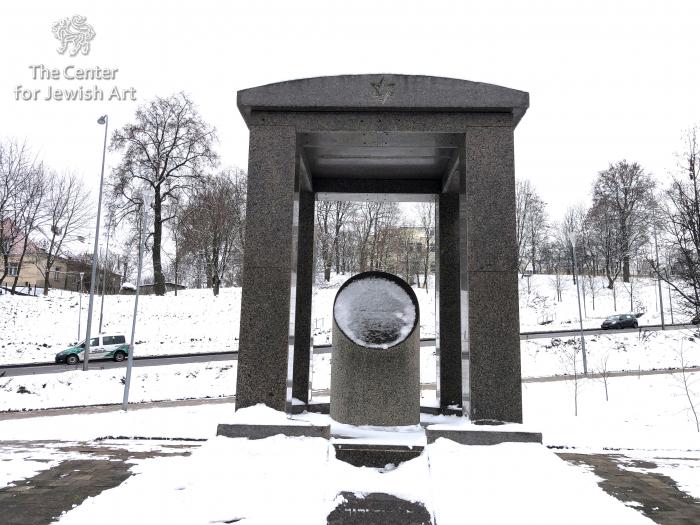Obj. ID: 45484 Memorial at the Cheap Houses in Vilnius, Lithuania, 1993

Who is Commemorated?
Jewish workers of the HKP forced labor camp.
Description:
The monument is situated to the south of the two buildings known as the Cheap Houses, in front of the tombstone monument at the site.
The monument consists of a square pyramidal pedestal tiled by granite, upon which stands a granite canopy with four pillars and a segmented roof. The gable of the roof is marked with a Star of David. A round column with a diagonally cut face is located in the center of the canopy. This face bears a depiction of a seven-branched menorah and a Hebrew inscription “Listen, Israel” in quotation marks followed by an ellipsis.
Central parts of each side of the pyramid are recessed and each of the recessed panels bears an inscription. There are identical inscriptions in Hebrew and Yiddish on the northern side, in English on the eastern side, and in Lithuanian on the western one. The donor’s inscription in Hebrew is on the back (southern) side of the monument.
Inscriptions:
On the column in the center, in Hebrew:
"שמע ישראל" ....
Translation: “Listen, Israel”….
Four identical inscriptions on the pedestal:
On the northern side, in Hebrew:
כל דוד ודור
גבורתם
לעד יזכור
On the northern side, in Yiddish:
פון דור צו דור
וויט מען אייביק
געדענקען
אייער גבורה
On the eastern side, in English:
From generation
to generation
your heroism
will be always
remembered
On the western side, in Lithuanian:
Iš kartos
į kartą
bus amžinai
minimas jūsų
didvyriškumas
Donor’s inscription on the southern side, in Hebrew:
נתרם ע"י משפחת
יעקב פרנר תל-אביב
Translation: Donated by the family of / Yaakov Prener, Tel Aviv
Commissioned by
Yeshayahu (Shaya) Epstein.
Funded by Yakov Prener, a former Vilnius Ghetto prisoner, whose relatives were murdered in the HKP camp.
The Cheap Houses were built in 1897-1898 in order to provide affordable and hygienic housing for poor Vilnius Jews.
With the German occupation in 1941, their Jewish dwellers were driven to their murders in Ponary or resettled in the ghetto. The two buildings were converted into a camp for the wives and children of Red Army officers who stayed in the city when the Red Army retreated. By the autumn of 1943, some of these women had been killed in Ponary and others were sent for forced labor in Germany, while the children were sent to orphanages. A plaque in memory of those women and children was affixed to the eastern building (49 Subačiaus St.) in the early 2000s.
In late August and early September 1943, the buildings were converted into an army vehicles repair shop known as The HKP (Heereskraftfahrpark Ost 562), and a labor camp for Jews working there. The idea to create a separate camp for Jewish workers was came from Major Karl Plagge, a German Officer and the head of the HKP (he would later be named as one of the Righteous Among the Nations in 2004). After the annihilation of the ghetto, the camp also housed wives, children and sometimes parents of the workers. In November 1943, there were 1,218 registered inmates and in March 1944 there were 1,257.
On March 27, 1944, a children’s Aktion was conducted, during which all children under the age of 16 were seized. According to some sources, the children were transferred to death camps in Poland, according to others they were killed in Vilnius and buried in the Third Jewish cemetery.
On July 1, 1944, Plagge announced that the HKP was being relocated because of the approaching Red Army and indirectly warned the prisoners about a planned murder. On July 3, 1944, those who were not hiding were sent to Ponary. On July 4, 1944, SS men undertook a search of the building, and the around 200 discovered Jews were shot immediately near the buildings. On July 9, the Red Army arrived to the camp and those who had not been found – about 150-200 people – were set free.
After the war, the buildings were used by the Soviets as a camp for German POWs.
The monument was erected on the initiative of Yeshayahu Epstein and funded by Yakov Prener, a former Vilnius Ghetto prisoner, whose relatives were murdered in the HKP camp. According to Žydų muziejus 1994, (p. 280), the monument was sponsored by Yeshayahu Epstein and the Government of Lithuania.
The monument was unveiled on July 13, 1993 (Guzenberg 2013, 60), commemorating the 50th anniversary of the destruction of the Vilnius Ghetto.
Agranovskii, Genrikh. Oni zdes’ zhili... Zametki o evreiskom nasledii Vilniusa (Vilnius: Versus Aureus, 2014)., 201.
Agranovskii, Genrikh and Irina Guzenberg. Vilnius: Po sledam Litovskogo Ierusalima. Pamiatnye mesta ereiskoi istorii i kul’tury, 2nd ed. (Vilnius: The Vilna Gaon Jewish State Museum, 2016)., 588.
Guzenberg, Irina, Vilnius: Sites of Jewish Memory. A Concise Guide. Second revised and supplemented edition. Trans. Svetlana Shatalova (Vilnius: Pavilniai Publishers, 2019)., 62-63.
Guzenberg, Irina, Vilnius: Traces of the Jewish Jerusalem of Lithuania. Memorable Sites of Jewish History and Culture. A Guidebook (Vilnius: Pavilniai, 2021)., 602.
Guzenberg, Irina, Žydų darbo stovykla HKP, 1943–1944: Dokumentai – Еврейский рабочий лагерь Х.К.П., 1943–1944: Документы – The H.K.P. Jewish Labor Camp, 1943–1944: Documents (Vilnius: The Vilna Gaon Jewish State Museum, 2002).
Guzenberg, Irina. Vilnius: Pamiatnye mesta evreiskoi istorii i kul'tury (Vilnius: Pavilniai, 2013)., 60.
Holocaust Atlas of Lithuania, THE HKP JEWISH LABOR CAMP, http://www.holocaustatlas.lt/EN/#a_atlas/search//page/1/item/120/., http://www.holocaustatlas.lt/EN/ (accessed December 20, 2022)
Itzhak Alfasi (ed.), Vilna yerushalayim de-lita hareva! haita ve-einena od (Tel Aviv, 1993), 24-27.
Jakulytė-Vasil, Milda. Lithuanian Holocaust Atlas (Vilnius: VIlna Gaon State Jewish Museum, 2011), 298-299.
Levinson, Yosif, Skausmo knyga. The Book of Sorrow. Dos bukh fun veytik. Sefer ha-keev (Vilnius: VAGA Publishers, 1997)., 48-49.
Žydų muziejus. Evreiskii muzei. The Jewish Museum, ed. Evsey Ceitlin (Vilnius: Lietuvos valstybinis žydų muziejus, 1994), 280.























